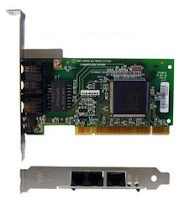OSI model to divide the stages of the process of internetworking (computer-to-computer), a set of layers or layer. Dimualai layer sequence of the bottom layer (first layer) until the top layer (last layer). In total there are seven layers to be grouped into two groups: the upper layer and lower layer. The following sequence of layers is
Upper layer
-Application layer
-Presentation layer
-Session layer-Presentation layer
Lower layer
-Transport layer
-Network layer
-Data link layer
-Physical layer
2. NIC (Netwok Interface Card)
NIC is the equipment directly related to computers and designed for network computers communicate with each other. NIC also provides access to physical media network. NIC is an example of devices that work on the first layer or physical layer
3. HUB
Hubs are devices that can double the frames of data from one computer to all ports on the hub. So that all computers connected to the hub port will receive data as well. Hubs are used on the network star
Hub has three categories:
A. Passive Hub (Concentrator)
Ordinary Hub which only forward the signal to all nodes. Passive hub will not amplify the signal coming in, so it can not be used to reach a larger area. Hubs like this works on physical layer
B. Active Hub (Multiport Repeater)
Functioning similar to a passive hub, but can amplify the signal coming in, so it can reach a larger area. Hubs like this also work on physical layer
C. Intelligent Hub
Intelligent hubs can generally be combined or stacked (sometimes called stackabel hub.) Hub of this type can also perform data destination selection address, so that only certain nodes can receive data. According to some sources of equipment such as routers, bridges and switches are examples of intelligent network hub. Hubs like this work on the data link layer.
Hub has three categories:
A. Passive Hub (Concentrator)
Ordinary Hub which only forward the signal to all nodes. Passive hub will not amplify the signal coming in, so it can not be used to reach a larger area. Hubs like this works on physical layer
B. Active Hub (Multiport Repeater)
Functioning similar to a passive hub, but can amplify the signal coming in, so it can reach a larger area. Hubs like this also work on physical layer
C. Intelligent Hub
Intelligent hubs can generally be combined or stacked (sometimes called stackabel hub.) Hub of this type can also perform data destination selection address, so that only certain nodes can receive data. According to some sources of equipment such as routers, bridges and switches are examples of intelligent network hub. Hubs like this work on the data link layer.
4. REPEATER Repeater is one example of an active hub. Repeaters are devices that can receive signals, keudian strengthen and sends the signal back to another place. So that the signal can reach more remote areas
5. BRIDGE
Bridge is a device that can connect several segments in a network. Unlike hubs, bridges can learn the MAC address of destination. So when a computer sends data to a particular computer, the bridge will send the data through a port that is connected with the destination computer only.
In general there are three categories of bridges, namely:
- Local bridge (Linking multiple LAN)
- Remote Bridge (Connecting LAN to WAN)
- Wireless bridge (Connecting LAN to remote nodes)
5. BRIDGE
Bridge is a device that can connect several segments in a network. Unlike hubs, bridges can learn the MAC address of destination. So when a computer sends data to a particular computer, the bridge will send the data through a port that is connected with the destination computer only.
In general there are three categories of bridges, namely:
- Local bridge (Linking multiple LAN)
- Remote Bridge (Connecting LAN to WAN)
- Wireless bridge (Connecting LAN to remote nodes)






0 comments:
Post a Comment